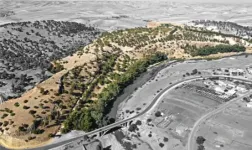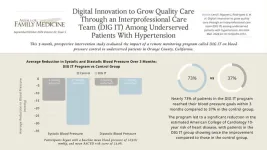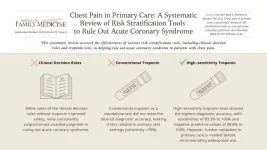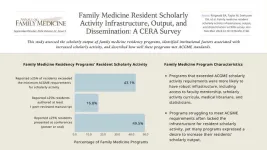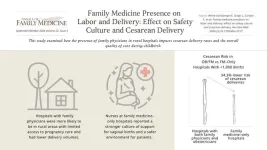(Press-News.org) Multi-disciplinary archaeological survey at the site of Oued Beht, Morocco, reveals a previously unknown 3400–2900 BC farming society.
This is the earliest and largest agricultural complex yet found in Africa beyond the Nile.
It shares similar features with contemporaneous sites in Iberia.
This suggests the Maghreb was instrumental to the shaping of the western Mediterranean during the fourth and third millennia BC.
Archaeological fieldwork in Morocco has discovered the earliest, previously unknown farming society from a poorly understood period of north-west African prehistory.
This study, published today in Antiquity, reveals for the first time the importance of the Maghreb (north-west Africa) in the emergence of complex societies in the wider Mediterranean.
With a Mediterranean environment, a border with the Sahara desert and the shortest maritime crossing between Africa and Europe, the Maghreb is perfectly located as a hub for major cultural developments and intercontinental connections in the past.
Whilst the region’s importance during the Palaeolithic, Iron Age and Islamic periods is well known, there is a significant gap in knowledge of the archaeology of the Maghreb between c. 4000 and 1000 BC, a period of dynamic change across much of the Mediterranean.
To tackle this, Youssef Bokbot (INSAP), Cyprian Broodbank (Cambridge University), and Giulio Lucarini (CNR-ISPC and ISMEO) have carried out collaborative, multidisciplinary archaeological fieldwork at Oued Beht, Morocco.
Prof Broodbank states: "For over thirty years I have been convinced that Mediterranean archaeology has been missing something fundamental in later prehistoric north Africa. Now, at last, we know that was right, and we can begin to think in new ways that acknowledge the dynamic contribution of Africans to the emergence and interactions of early Mediterranean societies"
As the authors state: "For more than a century the last great unknown of later Mediterranean prehistory has been the role played by the societies of Mediterranean’s southern, Africa shores west of Egypt. Our discoveries prove that this gap has been due not to any lack of major prehistoric activity, but to the relative lack of investigation, and publishing. Oued Beht now affirms the central role of the Maghreb in the emergence of both Mediterranean and wider African societies."
These results reveal that the site was the largest agricultural complex from this period in Africa outside of the Nile region. All of the evidence points to the presence of a large-scale farming settlement—similar in size to Early Bronze Age Troy.
The team recovered unprecedented domesticated plant and animal remains, pottery and lithics, all dating to the Final Neolithic period. Excavation also revealed extensive evidence for deep storage pits.
Importantly, contemporaneous sites with similar pits have been found on the other side of the Strait of Gibraltar in Iberia, where finds of ivory and ostrich egg have long pointed to African connections. This suggests that the Maghreb was instrumental in wider western Mediterranean developments during the fourth millennium BC.
Oued Beht and the north-west Maghreb were clearly integral parts of the wider Mediterranean region. As such, these discoveries significantly change our understanding of the later prehistory of the Mediterranean and Africa.
As the authors of the Antiquity article state: “It is crucial to consider Oued Beht within a wider co-evolving and connective framework embracing peoples both sides of the Mediterranean-Atlantic gateway during the later fourth and third millennia BC—and, for all the likelihood of movement in both directions, to recognise it as a distinctively African-based community that contributed substantially to the shaping of that social world.”
END
Previously unknown Neolithic society in Morocco discovered: shining light on North Africa’s role in Mediterranean prehistory
2024-09-23
ELSE PRESS RELEASES FROM THIS DATE:
Study finds PrEP use among gay and bisexual men in Ontario linked to higher STI rates
2024-09-23
Background and Goal: Pre-exposure prophylaxis (PrEP) is a preventive medicine that reduces the risk of contracting HIV. There is concern that PrEP use may be associated with an increase in bacterial sexually transmitted infections (STIs) like gonorrhea, chlamydia, and syphilis among men who are gay or bisexual. This study explored the relationship between PrEP use and the rates of bacterial STIs over time.
Study Approach: Researchers used data from the iCruise Study, an online longitudinal study of men who are gay or bisexual or have sex with men, in Ontario from July 2017 to April 2018. The study examined how PrEP use related to the number of self-reported ...
Technology-assisted health coaching intervention does not improve weight loss in veterans and high-risk patients
2024-09-23
Background and Goal: Obesity is a significant health issue, particularly among veterans and racial/ethnic minority groups. Primary care is a key setting for addressing obesity. However, many barriers, including time constraints and limited patient engagement, make effective treatment challenging. This study evaluated whether a technology-assisted health coaching intervention called Goals for Eating and Moving (GEM) could help high-risk patients lose weight more effectively than enhanced usual care (EUC).
Study Approach: Researchers conducted a two-arm, cluster-randomized controlled trial involving 19 primary care teams ...
Underserved patients reduce blood pressure and heart disease risk using remote monitoring program
2024-09-23
Background and Goal: Underserved communities are at higher risk for uncontrolled high blood pressure (hypertension), which can lead to heart disease and higher death rates. This study evaluated the impact of a remote monitoring program called DIG IT on blood pressure control in underserved patients at a Federally Qualified Health Center (FQHC) in Orange County, California.
Study Approach: Researchers compared two groups: 70 patients using the DIG IT program, which includes digital blood pressure monitoring, medication management, and a team-based care approach, and a historical control group of 70 patients who received standard care without digital tools. The ...
The HOMER study evolves to adapt opioid treatment research amid COVID-19 challenges
2024-09-23
Background and Goal: The HOMER study was launched to determine the most effective setting for starting buprenorphine treatment for opioid use disorder. The study faced challenges including shifts in health care delivery, changes in patient preferences, and the emergence of telehealth. The goal was to adapt the study to these circumstances while maintaining its focus on patient-centered care and effective treatment outcomes.
Key Insights: The HOMER study had to quickly adapt to challenges brought on by the COVID-19 pandemic. With community input, the study design evolved to include a third arm, ...
High-sensitivity troponin shows promise in diagnosing acute coronary syndrome in primary care settings
2024-09-23
Background and Goal: Chest pain is a common but challenging symptom for general practitioners to evaluate, as it can be caused by both serious conditions and more benign issues. This study assessed the effectiveness of various risk stratification tools, including clinical decision rules and troponin tests, in helping general practitioners rule out acute coronary syndrome in patients with chest pain.
Study Approach: Researchers conducted a systematic review of studies involving adult patients presenting ...
September/October Annals of Family Medicine Tip Sheet
2024-09-23
Original Research
Family Physicians in Rural Hospitals Associated With Lower Cesarean Rates and Safer Maternal Care Culture
Background and Goal: The U.S. is experiencing a maternal health crisis, particularly in rural areas. This issue is compounded by rising rates of severe maternal morbidity and mortality. Family physicians often fill critical gaps in care in rural areas where obstetricians are scarce. This study examined how the presence of family physicians in rural hospitals impacts cesarean delivery rates and the overall quality of care during childbirth.
Study Approach: The study analyzed data from rural ...
Risk model identifies advanced cancer trial patients at highest risk for acute care use
2024-09-23
Investigators from the SWOG Cancer Research Network have developed and validated a risk prediction model for identifying which patients with advanced cancer who are enrolled to clinical trials are at highest risk for unplanned emergency room (ER) visits and hospital stays.
Determining which patients are at significantly higher risk could inform interventions to reduce the need for such visits, improving care quality and reducing costs.
The work will be delivered as an oral presentation by Dawn L. Hershman, MD, MS, at the 2024 ASCO Quality Care Symposium, which will ...
Robust family medicine residency programs help residents meet scholarly output requirements
2024-09-23
Background and Goal: Family medicine residency programs are essential for training future primary care physicians. The Accreditation Council for Graduate Medical Education (ACGME) program requires family medicine residents to perform two scholarly projects. One must be a quality improvement project, and the second project type is at the program's discretion. This study assessed the scholarly activity output of family medicine residency programs in the U.S., identified institutional factors associated with increased scholarly ...
Using transparent capsules in dry powder inhalers could significantly improve medication delivery
2024-09-23
Background and Goal: This study examined whether patients with non-reversible chronic airway disease using a transparent capsule in single-dose dry powder inhalers affects the amount of medication delivered. The goal was to determine if patients who use transparent capsules that allow them to see if the medication has been fully inhaled have better inhalation results compared to those using opaque capsules.
Study Approach: Researchers conducted an observational cross-sectional study between October 2020 and October ...
Family physicians in rural hospitals associated with lower cesarean rates and safer maternal care culture
2024-09-23
Background and Goal: The U.S. is experiencing a maternal health crisis, particularly in rural areas. This issue is compounded by rising rates of severe maternal morbidity and mortality. Family physicians often fill critical gaps in care in rural areas where obstetricians are scarce. This study examined how the presence of family physicians in rural hospitals impacts cesarean delivery rates and the overall quality of care during childbirth.
Study Approach: The study analyzed data from rural hospitals in Iowa and collected survey responses from clinicians about their attitudes and practices related to ...
